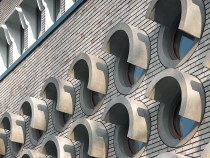
© Roland Halbe
During the fifteenth century, a Dominican monastery was built on this site; following the Reformation it was transformed into a Protestant church with accompanying hospital. The ensemble was destroyed completely during the Second World War. Only the altar and the south wall of the nave survived. Because the Protestant administration and meeting centre that had been built on the foundations in 1961 was no longer able to fulfil contemporary requirements, the decision was made to replace it with a new building.
The architects developed a design for the architectural competition that seized the opportunity to restore the monastery’s urban constellation. The L-shaped building massing now incorporates the alignment of the monastery, which is slightly skewed to the urban grid. On ground level, generously dimensioned corridors with French windows make reference to the former cloister, while the six fastigiate beech trees mark the piers that once stood in the nave. Exposed masonry of light-toned brick cloaks all of the facades, bestowing a sense of familiarity.
The facade is characterised by the elaborately articulated openings that are responses to the different uses of the spaces behind them. For example, the windows of the administration spaces facing the courtyard and Gymnasiumstraße are equipped with small roofs clad in aluminium sheet that facilitate ventilation when it rains and protect the fabric awnings from the elements. The 39 portholes in the northwest facade furnish light to the stage of the large hall. With wood shutters the amount of daylight entering the space can can be controlled. The four bay windows in the hall’s lobby also conceal a distinctive feature: integrated benches beckon to passersby.
The architects developed a design for the architectural competition that seized the opportunity to restore the monastery’s urban constellation. The L-shaped building massing now incorporates the alignment of the monastery, which is slightly skewed to the urban grid. On ground level, generously dimensioned corridors with French windows make reference to the former cloister, while the six fastigiate beech trees mark the piers that once stood in the nave. Exposed masonry of light-toned brick cloaks all of the facades, bestowing a sense of familiarity.
The facade is characterised by the elaborately articulated openings that are responses to the different uses of the spaces behind them. For example, the windows of the administration spaces facing the courtyard and Gymnasiumstraße are equipped with small roofs clad in aluminium sheet that facilitate ventilation when it rains and protect the fabric awnings from the elements. The 39 portholes in the northwest facade furnish light to the stage of the large hall. With wood shutters the amount of daylight entering the space can can be controlled. The four bay windows in the hall’s lobby also conceal a distinctive feature: integrated benches beckon to passersby.







